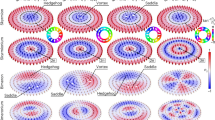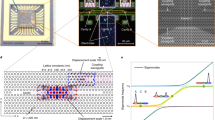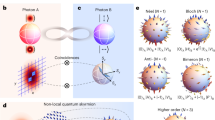Abstract
Skyrmions are topologically stable quasiparticles that have been investigated in contexts including particle physics, quantum field theory, acoustics and condensed-matter physics. Quantum optical skyrmions with local topological textures are expected to reshape the landscape of quantum photonic technology, although their experimental implementation has not yet been demonstrated. Here we present experimental realizations of nanophotonic quantum skyrmions using a semiconductor cavity quantum electrodynamics system. By manipulating the photonic spin–orbit coupling in a Gaussian microcavity, we obtained a confined optical mode whose polarizations feature skyrmionic topologies. With pronounced cavity quantum electrodynamics effects, we generated and detected single-photon skyrmions from a solid-state quantum emitter deterministically coupled to the Gaussian microcavity. The polarity associated with single-photon skyrmions can be swapped by flipping the polarization of the quantum emitter through the Zeeman effect. We also investigated the topological protection of quantum optical skyrmions under different perturbations. Our work opens an unexplored aspect of quantum light–matter interactions in the nanoscale and might advance resilient photonic quantum technology with high-dimensional qubits and high-capacity quantum memories.
This is a preview of subscription content, access via your institution
Access options
Access Nature and 54 other Nature Portfolio journals
Get Nature+, our best-value online-access subscription
$32.99 / 30 days
cancel any time
Subscribe to this journal
Receive 12 print issues and online access
$259.00 per year
only $21.58 per issue
Buy this article
- Purchase on SpringerLink
- Instant access to full article PDF
Prices may be subject to local taxes which are calculated during checkout





Similar content being viewed by others
Data availability
The data that support the plots within this paper and other findings of this study are available via figshare at https://doi.org/10.6084/m9.figshare.29162057 (ref. 56). Source data are provided with this paper. All other data used in this study are available from the corresponding authors upon reasonable request.
Code availability
All codes produced during this research are available from the corresponding authors upon reasonable request.
References
Skyrme, T. H. R. A non-linear field theory. Proc. R. Soc. A 260, 127–138 (1961).
Skyrme, T. H. R. A unified field theory of mesons and baryons. Nucl. Phys. 31, 556–569 (1962).
Duzgun, A. & Nisoli, C. Skyrmion spin ice in liquid crystals. Phys. Rev. Lett. 126, 047801 (2021).
Al Khawaja, U. & Stoof, H. Skyrmions in a ferromagnetic Bose–Einstein condensate. Nature 411, 918–920 (2001).
Han, L. et al. High-density switchable skyrmion-like polar nanodomains integrated on silicon. Nature 603, 63–67 (2022).
Song, K. M. et al. Skyrmion-based artificial synapses for neuromorphic computing. Nat. Electron. 3, 148–155 (2020).
Bogdanov, A. N. & Panagopoulos, C. Physical foundations and basic properties of magnetic skyrmions. Nat. Rev. Phys. 2, 492–498 (2020).
Wang, A. A. et al. Topological protection of optical skyrmions through complex media. Light: Sci. Appl. 13, 314 (2024).
Wang, R. et al. Observation of resilient propagation and free-space skyrmions in toroidal electromagnetic pulses. Appl. Phys. Rev. 11, 031411 (2024).
He, C., Shen, Y. & Forbes, A. Towards higher-dimensional structured light. Light: Sci. Appl. 11, 205 (2022).
Shen, Y. et al. Optical skyrmions and other topological quasiparticles of light. Nat. Photonics 18, 15–25 (2024).
Tsesses, S. et al. Optical skyrmion lattice in evanescent electromagnetic fields. Science 361, 993–996 (2018).
Du, L., Yang, A., Zayats, A. V. & Yuan, X. Deep-subwavelength features of photonic skyrmions in a confined electromagnetic field with orbital angular momentum. Nat. Phys. 15, 650–654 (2019).
Gao, S. et al. Paraxial skyrmionic beams. Phys. Rev. A 102, 053513 (2020).
Kuratsuji, H. & Tsuchida, S. Evolution of the Stokes parameters, polarization singularities, and optical skyrmion. Phys. Rev. A 103, 023514 (2021).
Shen, Y., Martínez, E. C. & Rosales-Guzmán, C. Generation of optical skyrmions with tunable topological textures. ACS Photonics 9, 296–303 (2022).
Lin, W., Ota, Y., Arakawa, Y. & Iwamoto, S. On-chip optical skyrmionic beam generators. Optica 11, 1588–1594 (2024).
Shen, Y., Hou, Y., Papasimakis, N. & Zheludev, N. I. Supertoroidal light pulses as electromagnetic skyrmions propagating in free space. Nat. Commun. 12, 5891 (2021).
Karnieli, A., Tsesses, S., Bartal, G. & Arie, A. Emulating spin transport with nonlinear optics, from high-order skyrmions to the topological Hall effect. Nat. Commun. 12, 1092 (2021).
Shen, Y. Topological bimeronic beams. Opt. Lett. 46, 3737–3740 (2021).
Zhang, Q. et al. Optical topological lattices of Bloch-type skyrmion and meron topologies. Photonics Res. 10, 947–957 (2022).
Marco, D., Herrera, I., Brasselet, S. & Alonso, M. A. Propagation-invariant optical meron lattices. ACS Photonics 11, 2397–2405 (2024).
Sugic, D. et al. Particle-like topologies in light. Nat. Commun. 12, 6785 (2021).
Ehrmanntraut, D. et al. Optical second-order skyrmionic hopfion. Optica 10, 725–731 (2023).
Shen, Y. et al. Topological transformation and free-space transport of photonic hopfions. Adv. Photonics 5, 015001 (2023).
Kerridge-Johns, W. R., Rao, A. S. & Omatsu, T. Optical skyrmion laser using a wedged output coupler. Optica 11, 769–775 (2024).
He, T. et al. Optical skyrmions from metafibers with subwavelength features. Nat. Commun. 15, 10141 (2024).
Shen, Y. et al. Topologically controlled multiskyrmions in photonic gradient-index lenses. Phys. Rev. Appl. 21, 024025 (2024).
Mata-Cervera, N. et al. Tailoring propagation-invariant topology of optical skyrmions with dielectric metasurfaces. Nanophotonics https://doi.org/10.1515/nanoph-2024-0736 (2025).
Hakobyan, V., Shen, Y. & Brasselet, E. Unitary spin-orbit optical-skyrmionic wave plates. Phys. Rev. Appl. 22, 054038 (2024).
Hakobyan, V. & Brasselet, E. Q-plates: from optical vortices to optical skyrmions. Phys. Rev. Lett. 134, 083802 (2025).
Ornelas, P., Nape, I., de Mello Koch, R. & Forbes, A. Non-local skyrmions as topologically resilient quantum entangled states of light. Nat. Photonics 18, 258–266 (2024).
Luo, X. et al. Non-Hermitian control of confined optical skyrmions in microcavities formed by photonic spin–orbit coupling. Photonics Res. 11, 610–621 (2023).
Zhou, X., Zhai, L. & Liu, J. Epitaxial quantum dots: a semiconductor launchpad for photonic quantum technologies. Photonics Insights 1, R07 (2023).
Wang, J. et al. Multidimensional quantum entanglement with large-scale integrated optics. Science 360, 285–291 (2018).
Chen, B. et al. Bright solid-state sources for single photons with orbital angular momentum. Nat. Nanotechnol. 16, 302–307 (2021).
Liu, X. et al. Heralded entanglement distribution between two absorptive quantum memories. Nature 594, 41–45 (2021).
Yang, J. et al. Tunable quantum dots in monolithic Fabry-Perot microcavities for high-performance single-photon sources. Light: Sci. Appl. 13, 33 (2024).
Li, F. et al. Tunable open-access microcavities for solid-state quantum photonics and polaritonics. Adv. Quantum Technol. 2, 1900060 (2019).
Whittaker, C. et al. Effect of photonic spin-orbit coupling on the topological edge modes of a Su-Schrieffer-Heeger chain. Phys. Rev. B 99, 081402 (2019).
Winger, M. et al. Explanation of photon correlations in the far-off-resonance optical emission from a quantum-dot–cavity system. Phys. Rev. Lett. 103, 207403 (2009).
Dufferwiel, S. et al. Spin textures of exciton-polaritons in a tunable microcavity with large TE-TM splitting. Phys. Rev. Lett. 115, 246401 (2015).
Lin, W., Ota, Y., Arakawa, Y. & Iwamoto, S. Microcavity-based generation of full Poincaré beams with arbitrary skyrmion numbers. Phys. Rev. Res. 3, 023055 (2021).
Bayer, M. et al. Fine structure of neutral and charged excitons in self-assembled In(Ga)As/(Al)GaAs quantum dots. Phys. Rev. B 65, 195315 (2002).
Petrovic, A. P., Psaroudaki, C., Fischer, P., Garst, M. & Panagopoulos, C. Colloquium: quantum properties and functionalities of magnetic skyrmions. Preprint at arxiv.org/abs/2410.11427 (2024).
Lodahl, P. et al. Chiral quantum optics. Nature 541, 473–480 (2017).
Chen, J., Forbes, A. & Qiu, C.-W. More than just a name? From magnetic to optical skyrmions and the topology of light. Light Sci. Appl. 14, 28 (2025).
Zheng, F. et al. Direct imaging of a zero-field target skyrmion and its polarity switch in a chiral magnetic nanodisk. Phys. Rev. Lett. 119, 197205 (2017).
Song, C. et al. Field-tuned spin excitation spectrum of kπ skyrmion. New J. Phys. 21, 083006 (2019).
Reindl, M. et al. Highly indistinguishable single photons from incoherently excited quantum dots. Phys. Rev. B 100, 155420 (2019).
Allen, L., Beijersbergen, M. W., Spreeuw, R. & Woerdman, J. Orbital angular momentum of light and the transformation of Laguerre-Gaussian laser modes. Phys. Rev. A 45, 8185 (1992).
Leyder, C. et al. Observation of the optical spin Hall effect. Nat. Phys. 3, 628–631 (2007).
Solnyshkov, D. & Malpuech, G. Chirality in photonic systems. Comptes Rendus Phys. 17, 920–933 (2016).
Göbel, B., Mertig, I. & Tretiakov, O. A. Beyond skyrmions: review and perspectives of alternative magnetic quasiparticles. Phys. Rep. 895, 1–28 (2021).
Nagaosa, N. & Tokura, Y. Topological properties and dynamics of magnetic skyrmions. Nat. Nanotechnol. 8, 899–911 (2013).
Ma, J. et al. Nanophotonic quantum skyrmions enabled by semiconductor cavity quantum electrodynamics. figshare https://doi.org/10.6084/m9.figshare.29162057 (2025).
Acknowledgements
This research was supported by the National Key Research and Development Program of China (Grant Number 2023YFA1407100 to F.L.), the National Natural Science Foundation of China (Grant Numbers 62035017 and 12361141824 to J.L., 62422516 and 12474397 to Y.Y., and 12474392 and 12074303 to F.L.), the Natural Science Foundation of Guangdong Province (Grant Number 2023B1515120070 to J.L.) and the National Super-Computer Center in Guangzhou.
Author information
Authors and Affiliations
Contributions
J.L. conceived the project. J.M., J.Y., S.L., Y.Y. and J.L. designed the epitaxial structure. J.Y. and C.S. grew the QD wafers. J.M., J.Y., S.L. and G.Q. developed the theoretical model and designed the devices. J.Y. and C.S. fabricated the devices. J.M., S.L., X.L., B.C. and K.Z. built the set-up and performed the optical measurements. J.M., F.L. and J.L. analysed the data. J.L. and J.M. prepared the paper with inputs from all authors. X.H., Y.Y. and J.L. supervised the project.
Corresponding authors
Ethics declarations
Competing interests
The authors declare no competing interests.
Peer review
Peer review information
Nature Physics thanks Yang Chen and the other, anonymous, reviewer(s) for their contribution to the peer review of this work.
Additional information
Publisher’s note Springer Nature remains neutral with regard to jurisdictional claims in published maps and institutional affiliations.
Extended data
Extended Data Fig. 1 Fabrication process of the Gaussian microcavity.
(a) Epitaxial growth of the bottom semiconductor DBR and QDs. (b) Fabrication of alignment markers. (c) QD positioning by the wide-field fluorescence imaging technique. (d) SiNx and SiO2 deposition by chemical vapor deposition (CVD). (e) Wafer with patterned exposed photoresist after aligned EBL. (f) Lensed-shape photoresist after heat reflow. (g) Lensed-shape SiO2 defect after dry etching. (h) Deterministically coupled QD-microcavity devices after the top dielectric DBR is evaporated.
Extended Data Fig. 2 Characterization of the engineered planar cavity with asymmetry.
(a) Deterministically coupled QD-microcavity devices. (b) Cross sections of the planar cavity. (c) Stimulated reflective spectrum of the symmetric planar cavity with cavity resonance in the center of the stopband. (d) Stimulated cavity modes of the symmetric Gaussian cavity, featuring vanishing SO coupling and exhibiting no mode splitting. (e) Stimulated reflective spectrum of the asymmetric planar cavity with the cavity resonance close to the edge of the stopband. (f) Stimulated cavity modes of the asymmetric Gaussian cavity, featuring appreciable SO coupling and exhibiting pronounced mode splittings. (g) Measured reflective spectrum of the asymmetric planar cavity in (e). (h) Measured cavity modes of the asymmetric Gaussian cavity in (f).
Extended Data Fig. 3 Principle of the formation of the skyrmion modes in Gaussian microcavity.
(a) Energy levels of the eigenstates of the third mode of the Gaussian cavity with strong spin-orbit coupling. (b) Calculated polarization states and Stokes components of mode 3-Ia and mode 3-Ib of analytical solutions and numerical simulation, which are in excellent agreement. The analytical solutions of the non-Hermitian model are done following the mathematics of Ref. 33 where the definitions of the parameters A and B are from the same reference.
Extended Data Fig. 4 Schematic of the setup for optical characterizations.
The sample with QDs embedded in Gaussian microcavities is located in a closed-cycle cryostat with a superconducting magnet. The base temperature of the closed-cycle cryostat is 1.8 K. The QDs can be excited by 785 nm continuous wave (CW) or pulsed lasers. The emitted single-photons are collected by a × 50 objective with a numerical aperture of 0.65 and sent to an electron-multiplying charge-coupled device (EMCCD) camera for imaging or coupled to a multimode fiber for spectral analysis, lifetime measurements and Hanbury-Brown-Twiss (HBT) measurements. DM1: 650 nm long-pass dichroic mirror, DM2: 805 nm long-pass dichroic mirror, BPF: band-pass filter, BS: beamsplitter, QWP: quarter-wave plate, HWP: half-wave plate.
Extended Data Fig. 5 Skyrmionium in the high-order mode of the Gaussian cavity.
(a) Simulated cavity modes of the Gaussian cavity with a radius of defect equal to 4 μm, which are excited by a σ+ dipole at the center of the cavity. (b) The polarization states and the extracted Stokes components of mode 5-I, mode 5-II, mode 7-I and mode 7-II shown in (a).
Supplementary information
Source data
Source Data Fig. 2
This source data file contains the raw data used to generate the plots in Fig. 2a,b.
Source Data Fig. 3
This source data file contains the raw data used to generate the plots in Fig. 3b,d–f.
Source Data Extended Data Fig. 2
This source data file contains the raw data used to generate the plots in Extended Data Fig. 2c–h.
Source Data Extended Data Fig. 5
This source data file contains the raw data used to generate the plots in Extended Data Fig. 5a.
Rights and permissions
Springer Nature or its licensor (e.g. a society or other partner) holds exclusive rights to this article under a publishing agreement with the author(s) or other rightsholder(s); author self-archiving of the accepted manuscript version of this article is solely governed by the terms of such publishing agreement and applicable law.
About this article
Cite this article
Ma, J., Yang, J., Liu, S. et al. Nanophotonic quantum skyrmions enabled by semiconductor cavity quantum electrodynamics. Nat. Phys. 21, 1462–1468 (2025). https://doi.org/10.1038/s41567-025-02973-y
Received:
Accepted:
Published:
Issue date:
DOI: https://doi.org/10.1038/s41567-025-02973-y



